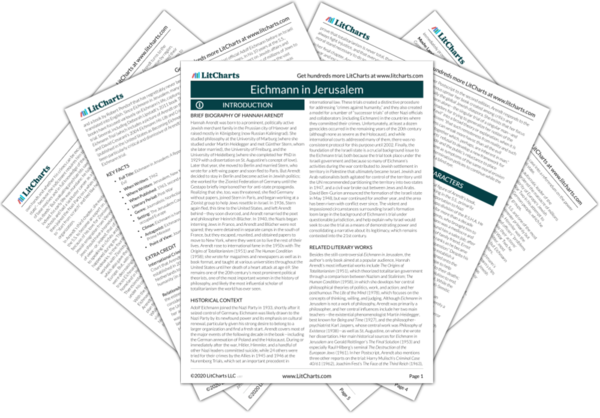In the Jerusalem courtroom, Eichmann sits beside the witness box in a glass booth designed especially for the occasion. More than a simple security measure, the glass booth also frames Eichmann as a spectacle for the trial’s expansive audience. Further, the wall of glass separating Eichmann from everyone else in the trial gestures to the invisible wall of words and ideology that, Arendt argues, prevents him from confronting the reality of his actions. Even though the consequences of his actions are right in front of him—the audience of Holocaust survivors in Jerusalem—he still fails to recognize his victims’ humanity and suffering. More than 50 years later, the booth remains a salient symbol of Eichmann’s trial and continues to be displayed in museums and other exhibits around the world.
The Glass Booth Quotes in Eichmann in Jerusalem
Justice demands that the accused be prosecuted, defended, and judged, and that all the other questions of seemingly greater import—of “How could it happen?” and “Why did it happen?,” of “Why the Jews?” and “Why the Germans?,” of “What was the role of other nations?” and “What was the extent of co-responsibility on the side of the Allies?,” of “How could the Jews through their own leaders cooperate in their own destruction?” and “Why did they go to their death like lambs to the slaughter?”—be left in abeyance. Justice insists on the importance of Adolf Eichmann, son of Karl Adolf Eichmann, the man in the glass booth built for his protection: medium-sized, slender, middle-aged, with receding hair, ill-fitting teeth, and nearsighted eyes, who throughout the trial keeps craning his scraggy neck toward the bench (not once does he face the audience), and who desperately and for the most part successfully maintains his self-control despite the nervous tic to which his mouth must have become subject long before this trial started. On trial are his deeds, not the sufferings of the Jews, not the German people or mankind, not even anti Semitism and racism.

Unlock explanations and citation info for this and every other Eichmann in Jerusalem quote.
Plus so much more...
Get LitCharts A+









